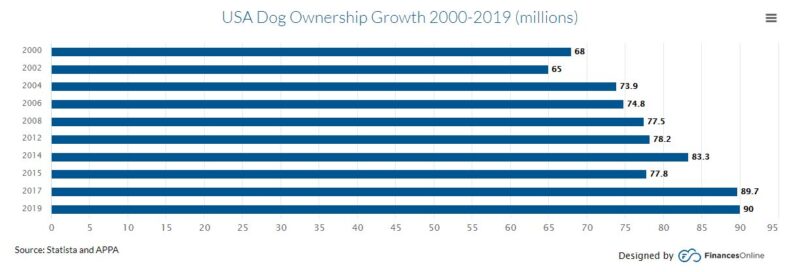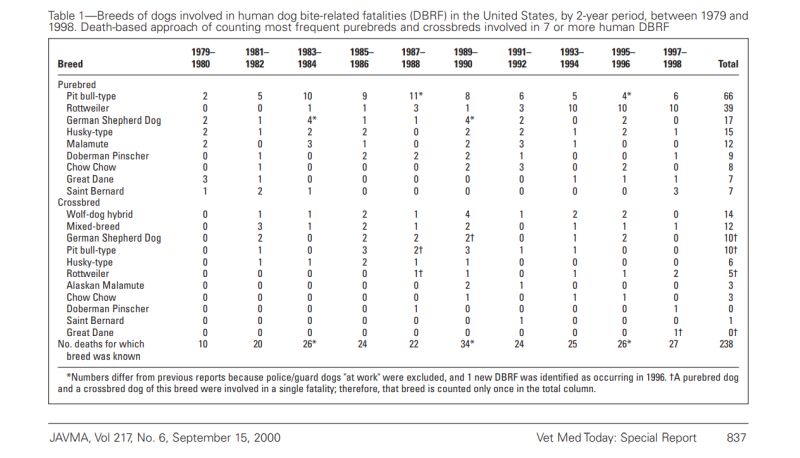The subject of dog bites is often quite contentious.
On the one hand, it deals with dogs, which most people – especially our readers – love.
But on the other hand, it deals with dog bites, which are frightening, traumatic, and even fatal in some rare cases.
Point being, emotions tend to run hot in these kinds of discussions. And that’s unfortunate, as this is a complicated issue, which deserves a deep, sober examination.
So, we’re going to dive in and tackle this topic with the nuance it deserves.
Read on to learn 10 statistics that will help you understand dog bites, the reasons they occur, and the relative risk different breeds and dogs present.
And then join us in the comment section, where we’re sure some will thank us, while others scream in our direction.
Dog Bite Statistics: Key Takeaways
- The statistics derived from different dog bite studies vary wildly. Methodology, study size, breed identifications, what qualifies as a “bite,” and a million other factors cause these discrepancies. Accordingly, you should never place too much weight on any single study.
- Broadly speaking, about 4.5 to 4.7 million people are bitten by dogs each year. This means that your odds of suffering a dog bite in any given year are approximately 1 in 70, but your odds of being killed by a dog in any given year are less than 1 in 18 million.
- It is exceptionally hard to determine which dog breed is responsible for the most bites. Different studies have come to different conclusions, though a handful of breeds do routinely appear at the top of most lists.
Dog Bite Statistic #1: How Many Dog Bites Occur Each Year?

It’s impossible to determine exactly how many dog bites occur each year, as many are very minor and go unreported.
But the Centers for Disease Control and Prevention (CDC) conducted a study that sought to determine the best answer possible. In doing so, they found that approximately 4.7 million dog bites occurred in the United States in 1994.
They arrived at this figure by conducting a phone survey of more than 5,000 randomly dialed households and then scaling those numbers up to the entire U.S. population. It bears mentioning that the CDC’s report on non-fatal dog bites (the first link above) cites the 4.7 million figure, while the actual study (the second link above) reports 4,494,083 bites occurred during 1994.
The reason for the discrepancy isn’t entirely clear.
Minor discrepancy aside, the CDC and several other organizations (such as the American Veterinary Medical Association) use 4.5 million as a reasonable yearly average for dog bites in the United States.
The annual global total is certainly much higher than this, but, as the World Health Organization (WHO) reports, there are no estimates for the number of bites that occur worldwide.
The United States has roughly 4 to 5 percent of the world’s population, so for an incredibly rough estimate, the yearly dog bite total for the world is likely on the order of 80 to 100 million.
But again, there’s no way to verify this. And given the problems many developing nations have with feral and stray dogs, this figure likely underestimates the total.
It’s really hard to determine how many dog bites occur each year, since so many go unreported. But a general estimate would be 4.5 million per year in the United States.
Dog Bite Statistic #2: Are Dog Bites Becoming More or Less Common?

Starting in the 1970s, journalists, laypersons, and academics began throwing around the word “epidemic” in reference to the dog bite problem, and many claimed that the number of dog bites were increasing drastically.
But like many other sensationalistic narratives of the past, it wasn’t an especially accurate contention. In fact, as demonstrated by the National Canine Research Council, the incidence of dog bites has dramatically decreased since the 70s.
You can see several examples in the chart below, but just check out the first one: Approximately 40,000 dog bites were reported in LA County in 1972. By contrast, only 8,365 were reported in 2011.

But before we place too much weight on these statistics, it is important to consider how the overall number of dogs (or the percentage of homes with dogs) has changed over time. If the pet population plummeted since the 70s, these figures wouldn’t be very reassuring.
But that clearly hasn’t happened – in fact, the opposite trend has occurred.
We can’t find reliable statistics concerning the number of homes with dogs or the overall canine population in the U.S. dating back to the 70s. But it’s generally accepted that dog ownership has been increasing over the long term. There have been a few isolated years in which the dog population or percentage of U.S. homes with dogs has decreased (such as 2002 and 2015), but the general trend line clearly points up.
For example, the AVMA reports that there were 69.9 million dogs in the United States in 2012, and they lived in 43.3 million homes (36.5% of the total U.S. households). By 2017/2018, the U.S. dog population rose to 76.8 million, with 48.2 million homes (38.4%) housing a four-footer.
And these number have continued to grow. By 2019/2020, the American Pet Products Association estimated that 63.4 million homes had a resident Rover, for a nationwide total of 89.7 million dogs.

Other sources have arrived at slightly different figures, but they’ve all demonstrated the same basic trend: a long-term rise in pet ownership.
For example, the pet industry marketing firm Packaged Facts reports that the number of households harboring dogs has risen a staggering 36% since 2009. And in August of 2020, they predicted that by the end of the year, the number of homes with a dog would reach 71 million.
Just to make this clear, approximately 27.7 million more U.S. homes had a dog at the end of 2020 than did a mere 8 years prior.
Statista provides a slightly different set of figures, but they demonstrate exactly the same trend line: 68 million homes owned a dog in the year 2000, while 89.7 million homes owned a dog by 2017.
So, the question is, have dog bites become more or less common relative to this increase in the number of dogs living in the country?
It stands to reason that dog bite statistics would rise over this time – there are more dogs and people present now than there were any number of years ago (using Statista’s figures, the U.S. population has increased from 282 million in the year 2000 to 325 million in the year 2017).

But the National Canine Resource Council’s figures show that this just isn’t true. Remember, they showed a precipitous decline in the number of bites over a roughly 40-year time frame.
Nevertheless, because we can’t verify the number of dogs who lived in the U.S. during the 70s, we’ve tried to compare some more recent statistics.
Unfortunately, this hasn’t proven easy.
There aren’t a lot of studies we can find that have made apples-to-apples comparisons of dog bite numbers over time, which we can correlate to areas and time frames for which we can determine the change in the local dog population.
A 1998 study published in JAMA reported that between 1992 and 1994, there were approximately 914 dog bite patients showing up in emergency rooms per day. By 2001, the CDC reports that this number rose to 1,008 daily emergency room visits caused by dog bites. This represents a 10% increase in the number of bites over the period in question.
So, how did the human and dog population numbers change over that period?
We can’t find figures that precisely match those derived from the study in JAMA and the CDC’s report, but we found pretty close ones.

According to figures published in The State of Animals II, there were approximately 52.5 million dogs in the United States as of 1991. This number rose to 61.6 million dogs by the year 2001.
The human population also grew over this time period. Using Statista’s numbers, there were 252 million people living in the U.S. in 1991, but there were 285 million people in the country by 2001.
This all means that:
- Emergency room trips for dog bites rose 10% between 1992 and 2001.
- The dog population grew by roughly 17% during roughly the same time.
- The human population grew by approximately 13% over this period.
The takeaway?
According to this data, emergency room trips caused by dog bites did become more common during this time period. However, this increase did not match the increase in the number of dogs or people in the country.
In other words, the number of bites that sent people to the emergency room did not match the growth in the number of people or pets in the country.
Put even more simply: The relative risk of a serious dog bite is going down.
Smaller-scale data also supports this notion. Take postal workers, for example. Because of the nature of their work, USPS employees are involved in a relatively high number of bite incidences. And once again, the data shows that the frequency of dog bites in this subgroup has decreased.
Postal workers in 2018 suffered approximately 1,000 fewer bites than they did in 2016 – a nearly 15% decrease in the number of bites.
But there are a number of different ways to approach this issue, and we can also look at the relationship between bite frequency and the population growth of pets and people another way.
For example, we can consider insurance company data.
This seems especially helpful, given the obvious financial interest insurance companies have in the number of dog bites — after all, they are the ones who ultimately end up footing the bill for dog bites.
Once again, it appears that dog bites are declining in frequency, despite increases in the number of dogs and people in the country.
Insurance Information Institute reports that dog bite claims nationwide fell by about 4% between 2019 and 2020.

The reasons for this decline in reported dog bites isn’t entirely clear.
However, it’d be reasonable to think that increased rates of spaying and neutering and a general improvement in the way owners care for their pets in the modern world play a part. For example, while we can’t find concrete numbers demonstrating as much, it seems likely that fewer owners allow their dogs to roam freely compared to 40-odd years ago.
Additionally, fewer owners leave their dog cruelly chained day and night in the backyard, and more owners invest the time and money needed to address aggression and other behavioral problems in dogs.
Generally speaking, the number of dog bites reported each year has been declining since the 1970s. And this has occurred despite significant increases in the number of dogs and people in the country.
Dog Bite Statistic #3: How Serious Are Most Dog Bites?

Dog bites obviously vary in severity. Some are relatively harmless nips that fail to even break the skin, while others are very serious and may even lead to the victim’s death.
In 1994, the CDC reports that approximately 800,000 of the 4.7 million people bit in the U.S. either sought medical attention or were forced to restrict their activity level.
In other words, roughly 17% of the dog bites were bad enough to qualify as “serious.”
Nevertheless, there’s a big difference in “serious enough to require some first-aid at the hospital” and “serious enough to require hospitalization.”
And fortunately, of all the dog bite victims treated in U.S. emergency departments in the year 2001, 96.2% of victims were treated and released, while only 1.6% were hospitalized.
Some dog bites are, however, as serious as you can get, and ultimately result in the death of the victim.
The number of dog-bite related deaths obviously fluctuates from year to year, but the CDC reports that 279 fatal bites occurred over a 15-year period, which averages out to a little more than 18 fatalities per year.
It bears mentioning that bites in some other countries are an even greater health hazard than they are in the United States, due to the threat of rabies.
In fact, dogs account for 99% of all rabies transmissions in humans, worldwide.
Rabies is nearly 100% fatal without treatment, but with prompt and competent medical care, the disease can usually be prevented from taking hold.
Fortunately for those of us in the states, mandatory vaccination programs have all but eliminated the rabies problem in dogs for the U.S. The CDC estimates that fewer than 70 dogs are reported rabid in the U.S. each year.
While there are a significant number of dog bites each year, only a small percent of all bites are serious enough to require an emergency room visit, and an even smaller fraction require hospitalization.
Dog Bite Statistic #4: The Dollars and Cents of Dog Bites

Dog bites are undeniably stressful events, which are difficult for all parties involved. Bites not only involve physical injuries, but also emotional trauma for the victim, the dog, and the owner.
Nevertheless, bites also involve a monetary component.
Victims may need expensive medical care and owners may find themselves looking down the business end of a lawsuit. There may also be veterinary bills involved, if the dog suffered an injury during the altercation.
According to the AVMA, approximately $854 million was spent on dog-bite claims in the United States in the year 2020.
Bites do seem to be declining over the long run (see statistic #2 above), but it is important to note that this represented a 7% increase over the previous year.
On average, individual insurance claims in this period were approximately $50,425. As with the total amount paid out by insurance companies, the average cost of individual claims also increased between 2019 and 2020.
According to the Insurance Information Institute, the average claim in 2019 was $44,760, meaning that the average claim crept up about 12% in 2020.
While these average figures are helpful for giving owners an idea of the potential costs of a dog-bite claim, it is important to understand that geography plays a big role in determining the exact cost of a specific bite.
For example, the average claim in Ohio was only $38,009, while the average claim in Nebraska – the state with the highest average claim – was $71,243.
The amount of money paid for dog bite claims has generally been increasing year over year.
Dog Bite Statistic #5: Where Do Most Dog Bites Occur?

The location in which a dog bites is a very important piece of information.
Not only does bite location provide clues to the circumstances surrounding the bite, but it also relates to the bite’s severity.
For example, a bite to the hand may be the result of misplaced aim on the dog’s part or it may occur when a person tries to separate quarreling dogs.
But a bite to the face or throat likely implies a more frightening intent, and it is also far more likely to cause serious injuries.
According to data collected from U.S. hospital emergency rooms in 2001:
- 45.3% of the bites were located on the hands or arms
- 25.8% of the bites were directed at the legs or feet
- 22.8% of the bites occurred in the victim’s head or neck
- Roughly 5% of the bites were on the upper or lower trunk
These figures seem to be consistent with the intuitive understanding of dog bites, and it’d be easy to envision multiple ways in which a victim would be bitten on the hands, arms, feet, or leg (bites to these regions total approximately 71% of all bites in the study).
It is important to note that bite location appears to vary with the victim’s age – particularly in the case of minors.
For example, 86.2% of bites in children 15 years of age or older occurred on the hands, arms, legs, or feet. By contrast, 64.9% of all bites to children younger than 5 years were directed at the head or neck.
This actually makes perfect sense when you think about it: Young children are smaller, tend to hang out on the floor, and have their face at mouth-level to a dog for longer periods of time.
Young children are also less knowledgeable about canine consent (the notion that your dog should be given the choice whether to engage in play or other activities) and may choose to chase, harass, or annoy a dog relentlessly until the dog feels that biting is his only recourse.
Over 70% of dog bites occur on the victim’s extremities (hands, arms, feet, or legs) — places which are unlikely to lead to fatalities. However, young children are more likely to die from a dog attack, as they receive more face and neck injuries, due to their shorter statures.
Dog Bite Statistic #6: Who Gets Bitten by Dogs?

The risk of suffering a dog bite isn’t the same for everyone. A litany of factors influence the likelihood that you’ll suffer a bite, including things like sex and age, among others.
Some of the most interesting statistics involving dog bites include:
- Men are more likely to be bitten than women. According to the CDC, U.S. emergency rooms reported that 55.1% of bite victims were male, while 44.9% of bite victims were female.
- Perhaps most troublingly, children are the victims in approximately 80% of all fatal dog attacks.
- Children between the ages of 5 and 9 were the most common age group treated for bite wounds in U.S. emergency rooms, and they represented 15.2% of all patients. Children between 10 and 14 were the second most commonly treated group, narrowly edging out children younger than 5 years of age.
- Collectively, adults between the ages of 25 and 44 accounted for approximately 25% of all bites, but this represents two distinct age cohorts. Individually, the 25 to 34 and 35 to 44 age groups each represented about 12% of all bites.
Fortunately, and with all deference to mail carriers, delivery drivers, and others who frequently come into contact with sometimes-aggressive dogs during the course of their work, you don’t appear particularly likely to suffer a bite while on the job.
In total, only 4.5% of bites landing the victim in the emergency room in 2001 were work-related. And obviously (though the CDC didn’t investigate this factor), many of these people undoubtedly work with dogs in veterinary, training, or other high-risk contexts.
Children are the victims of roughly 80% of all fatal dog attacks. In addition, men are more likely to be bitten by dogs than women.
Dog Bite Statistic #7: Which Breeds Bite the Most?

This is the question and related statistic most people want to know: Which dog breed bites the most?
Unfortunately, it is difficult to provide a simple answer to this question – despite what some less-than-reputable sources on the web would have you believe.
We’ll discuss some of the reasons it’s difficult to arrive at an answer to this question in a moment, however, one key factor is that many formal studies examining the intersection of dog breed and dog bites come to different conclusions.
Nevertheless, we’ll share some of the most noteworthy academic investigations into the issue and provide some general notes about each. However, readers who really want to understand this issue are encouraged to read the actual studies.
According to a 2010 study conducted in the Netherlands, mixed breed dogs (212), Jack Russell terriers (114), and Belgian shepherds (58) were responsible for the most bites.
However, as we discuss below, this study relied entirely on the survey respondents to identify the dog’s breed.
This is a very unreliable method to identify the breeds involved in bite incidents.
In the year 2000, a special report was published in the Journal of the American Veterinary Medical Association.
While the study provides valuable data, it is important to note that it specifically looked at dog bite fatalities rather than simple bites.

This presents a clear problem when considering which breeds bite most: This study is strongly biased toward large breeds. No matter how savagely a dachshund bites you, you’re unlikely to die from the ordeal. We’re not saying it’s impossible (especially if a small child were involved), but it’s certainly not likely.
Nevertheless, as you can see in the chart below, “pit bull type” dogs, Rottweilers, German shepherds, and “husky type” dogs ranked first through fourth, respectively, in causing deaths over the course of the study.

However, the authors of the study share a number of caveats:
Although fatal attacks on humans appear to be a breed-specific problem (pit bull-type dogs and Rottweilers), other breeds may bite and cause fatalities at higher rates. Because of difficulties inherent in determining a dog’s breed with certainty, enforcement of breed-specific ordinances raises constitutional and practical issues. Fatal attacks represent a small proportion of dog bite injuries to humans and, therefore, should not be the primary factor driving public policy concerning dangerous dogs.
There’s one other study that’s frequently cited in discussions of the breeds associated with dog bites. It was conducted by The Coalition for Living Safely with Dogs (CLSD) and the Colorado Association of Animal Control Officers (CAACO).
The data collected is referenced by a few different websites, but — try though we may — we simply cannot find a copy of the actual study. We’ve reached out to the study’s authors, we’ve flexed our Google skills, and tracked down every lead we could find. Zip, zilch, nada.
A synopsis of the data on CLSD letterhead is the best thing we’ve been able to find. In fact, it appears that the CLSD may be defunct. A few of the key findings include:
- Labrador retrievers were the breed most commonly identified in bites, and the dogs were responsible for 11.3% of the bites reviewed in the study.
- 17% of the bites involved dogs running at large (regardless of breed).
- One fatal attack was attributed to a miniature schnauzer(!)
- Of the attacks that resulted in serious bodily injury, 28% were attributed to pit bulls, 14% were attributed to German shepherds, and 10% were attributed to American bulldogs.

DVM 360 also published an analysis of the study and provide some other interesting tidbits. For example:
- Chihuahuas were the breed that was most likely to bite veterinarians.
- Lhasa apso dogs caused the most damage during bites, but it isn’t clear whether this is because people were less careful around the small breed or if the figure was calculated on a “per pound” basis.
The breeds responsible for the most bites in this study include:
- Labrador retrievers (13 percent)
- Pit bulls (8.4 percent)
- German shepherds (7.8 percent)
- Rottweilers (3.9 percent)
- Chow-chows (3.5 percent)
Another study — this time specifically examining bites to the face — was conducted in 2019 and published in International Journal of Pediatric Otorhinolaryngology.
They report that the breed that bit people the most was actually “unknown.” This makes sense, given the problems associated with identifying breeds based on their appearance.
Following “unknown,” the next five breeds listed were (in order):
- Pit bull
- Mixed breed
- German shepherd
- Terrier
- Rottweiler
The five breeds who bit the least often in the study were:
- Dalmatian
- Pointer
- Great Dane
- Pekingese
- Spitz
But there are plenty of problems here. For starters “terrier” isn’t a breed, nor is “spitz.” They’re breed groups, consisting of multiple individual breeds.
Additionally, these studies haven’t been able to address the popularity of the breeds involved in these bites. This is important, as the more common a given breed of dog becomes, the more likely the incidence of bites or attacks are to increase.
The adoption of shelter dogs has also become increasingly common in the last few decades, which complicates the identification of the breeds involved in bites. It also alters the relative numbers of different breeds who’re kept as pets, given that many of the dogs who end up in shelters are “pit-bull type” dogs, who’re left to roam unspayed or unneutered in many rural areas, particularly within the southern U.S.
While it’s not unusual for smaller dogs to bite as much (if not more) than large dogs, the force of a larger dog’s bite is more likely to require first aid (and more likely to be reported).
Different studies have labeled different breeds as the “most common biters,” but categorization and data collection issues abound. The unreliability of visual breed identification makes sorting bites by breed even more difficult, problematic, and ultimately unhelpful.
Dog Bite Statistic #8: The Factors Most Commonly Associated with Dog Bites

Although it is understandable, the tendency for people to focus on the breed involved in a dog bite is unhelpful and often misleading.
Visual breed identification is notoriously unreliable, and generally, a dog’s breed has less to do with a bite incident than the situational context surrounding the bite does.
In other words, in the aftermath of a bite, it is wiser to consider the circumstances surrounding the incident than the breed of the dog in question. This, it turns out, provides much better information, which will allow dog lovers and other interested parties avoid bites in the future.
In 2013, scientists with Tufts University published an analysis of 256 dog bite fatalities that occurred in the United States between 2000 and 2009. In the course of their work, the researchers sought to identify factors that may have led to the bite.
Now, it should be noted that the bites reviewed in this study were obviously very serious, and they did not review reports of minor bites. However, the information gleaned from the study should still prove instructive.
The researchers found that the bites were characterized by a small number of co-occurring factors.
And most importantly, these factors were all preventable.

For example, the study determined that:
- 85% of the victims had no familiar relationship with the dogs
- 84% of the dogs involved in these bites were not spayed or neutered
- 76% of the biting dogs were deprived of regular, positive interaction with humans
- 87% of the time, another able-bodied person was unable to intervene
- 77% of the time, the victim did not interact appropriately with the dog
- 37% of the dogs were formerly exposed to improper management by the owner
- 21% of the dogs had been abused
It’s also important to note that four or more of these factors were involved in 80.5% of the attacks reviewed.
However, the most important takeaway from the study was that the dog’s breed was not a factor in these bites. Ultimately leading the authors to conclude that:
Study results supported previous recommendations for multifactorial approaches, instead of single-factor solutions such as breed-specific legislation, for dog bite prevention.
It is more conducive to focus on the preventable factors common to most dog bite occurrences than the dog’s breed.
The vast majority of bites occur: (1) when a stranger interacts with an unfamiliar dog, (2) when a dog is isolated and lacks positive interactions with humans, and (3) when a dog is interacted with in a way that is not appropriate.
With that in mind, encouraging preventive measures and careful, knowledgeable interactions with dogs may be the most effective way to reduce dog bites.
Dog Bite Statistic #9: Dog Aggression Statistics vs Dog Bite Statistics

If your goal is to assess your risk of being bitten by a dog, it may be more helpful to consider statistics relating to dog aggression, rather than actual bites.
Think about it: Of all the bites recorded in the CDC’s 4.7 million figure, how many attempted bites went unrecorded? For that matter, how many dogs were ready and willing to bite, yet did not because the human escaped or slipped away in the nick of time.
And because an attempted bite is almost as troubling as a successful bite in many ways, it makes sense to factor general canine aggression (particularly human-targeted aggression) in our overall analysis.
For example, an often-cited study, led by researcher Deborah L. Duffy and published in a 2008 issue of Applied Animal Behavior Science, conducted owner surveys of more than 30 dog breeds. One of the surveys was conducted online and the other involved a random sampling of breed club members.
This study utilized the Canine Behavioral Assessment and Research Questionnaire (CBARQ) to rank the aggression level of different breeds in different circumstances.
The authors appear to share our concerns about relying solely on bite reports, and they caution that bite reports can be misleading.
They cite three reasons for this:
- Most dog bites go unreported unless medical attention is sought (which may be more likely with larger breeds that have the ability to inflict more serious injury).
- The total number of dogs of a given breed in the local community is seldom known, so the degree to which that breed is over-represented among reported dog bites is usually undetermined.
- In many cases the breed of dog involved cannot be verified.
Note: We reformatted the above section from the original report to make it easier to read. See the fourth paragraph of the introduction for the authors’ verbatim quote.
The study analyzed several different types of aggression among dogs (aggression directed toward strangers, other dogs, or owners, among others). But for our purposes here, aggression directed toward strangers is likely the most appropriate to examine.

For example, the study lists the number of dogs from the breed club surveys who scored a 4 (the maximum score) for aggression. This means that the dogs exhibited “snaps, bites, or attempts to bite.”
You can see the chart below, but here are a few key takeaways:
- Among 11 breeds, Yorkshire terriers had the highest relative incidence of aggression directed at strangers (7.78%).
- Dachshunds ranked second among the 11 breeds, with 6.67% of those surveyed demonstrating stranger aggression.
- 5.43% of the individual Rottweilers surveyed displayed stranger-directed aggression, good enough for third place among the 11 breeds.

The online survey component of the study found broadly similar trends among breeds.
- Once again, dachshunds led the way, with 20.6% of individuals scoring a 4 for stranger aggression.
- Chihuahuas ranked second among 33 breeds, with 16.1% receiving a score of 4 for stranger aggression.
- Australian cattle dogs held down third place, with 9.6% of individuals scoring a 4 for stranger aggression.

When analyzing the breeds common to both owner and breed club surveys, mean aggression scores determined that dachshunds were the number one ranking breed for stranger-directed aggression in both cases. The rest of the breeds exhibited differing mean aggression scores, depending on which survey group was referenced.
For example, Rottweilers were ranked second in stranger-directed aggression among breed club members, whereas English springer spaniels earned the number two spot in the online survey.
According to this review discussed above, that cute little wiener dog you see at the park is statistically more likely to be aggressive toward you than a pit bull is.
Dog Bite Statistic #10: What Is Your Relative Danger of Suffering a Dog Bite?

Ultimately, we all have to accept some risk just to get through life.
You could die in a car accident tomorrow. You probably won’t, but it is a possibility.
You may also be struck by a meteorite. The odds of that happening are lower than dying in a car wreck, but they’re not zero.
So, one of the important things people should consider is their relative risk of suffering a dog bite.
Using the current U.S. population of approximately 332 million, we can determine that your odds of being bitten by a dog are roughly 1 in 70 to 1 in 73 (depending on which CDC number you use). We’ll stick with the 1 in 70 figure, for round numbers’ sake.
| Event | Odds | Source |
| Getting Food Poisoning | 1 in 6 | FoodSafety.Gov |
| Being in a Car Accident | 1 in 49 | National Highway Traffic Safety Administration |
| Being Bitten by a Dog | 1 in 70 | CDC |
| Being Diagnosed with Cancer | 1 in 184 | American Cancer Society |
| Suffering a Heart Attack | 1 in 412 | CDC |
| Dying from Heart Attack | 1 in 506 | CDC |
| Dying from Cancer | 1 in 547 | American Cancer Society |
| Dying from COVID 19 in the year 2020 | 1 in 862 | CDC |
| Suffering a Firearm-Related Death | 1 in 8361 | UC Davis Health |
| Being Killed in a Car Accident | 1 in 8736 | Association for Safe International Road Travel |
| Being Struck by Lightening | 1 in 500,000 | CDC |
| Dying in Tornado, Storm, or Hurricane | 1 in 1,307,086 | Texas Tech University |
| Being Killed by Bee, Hornet or Wasp | 1 in 5,354,838 | CDC |
| Being Killed by a Dog | 1 in 18,444,444 | CDC |
So, what’s the takeaway?
Your odds of being bitten by a dog in any given calendar year aren’t really that low.
You’re more likely to suffer from food poisoning or be involved in a car accident than be bitten by a dog. But, unfortunately, dog bites aren’t a super-rare phenomenon.
By contrast, your odds of dying from a dog attack are very low. You’re far more likely to be killed by a novel respiratory virus, lightning, or a tornado than a dog.
An individual’s risk of dying from a dog bite is incredibly low. You’re much more likely to be killed by lightning, a tornado, or in a car accident.
The Problems with Dog Bite Statistics

Spend 15 minutes perusing Google’s results for dog bite statistics and you’ll likely come away shaking your head. Different sites report different figures, many fail to properly cite the source of their numbers, and some deliberately mischaracterize the researchers’ findings.
Bottom line: It’s hard for the average Joe or Joann to get a handle on dog bite statistics and really understand the issue. There are a few reasons for that, as well as some general problems with the subject of dog bite statistics.
We’ll discuss a few of the most common such issues below.
Cherry-Picking to Support a Narrative Is Common
Some organizations have a blatantly obvious agenda, which leads to rampant cherry-picking and disingenuous analysis.
One such particularly vocal organization – which we won’t mention by name – is clearly dedicated to the eradication of an entire breed, and the statistics they use are unfailingly biased. However, it is also important to acknowledge that some groups opposing breed-specific legislation are guilty of the same.
Unfortunately for the casual dog-lover interested in learning about dog bite statistics, this means you’ll have to be very selective about the sources you trust.
The Primary Source Material for Studies Examining Dog Bites Is Often Problematic
Many of the studies examining dog bite statistics rely on questionable sources, such as members of the general public.
For example, while the study is quite impressive when viewed in totality, a 2010 Dutch project collected data about dog bites via an internet survey.
Guess how well that went.
For example, when characterizing the user-submitted accounts of dog bites, the researchers stated:
nine were dropped because the respondents had indicated that no dog bite incident had occurred.
That’s right – nine people submitted dog bite reports to a dog bite survey without having suffered a dog bite.

Another big problem is that people are notoriously bad at identifying dog breeds.
From the same Dutch study referenced earlier:
Almost every respondent (92%) specified the aggressor’s breed while looking at the identification poster. In total, 86 different breeds of dogs were identified, 764 dogs of a specific breed, 212 dogs of the group mixed breed/mongrel, and 102 dogs were of unknown breed. When asked how certain the respondents were about their answer on this question, 77% indicated they were ‘very certain’ and 19% indicated they were ‘certain’.
But just because respondents were “certain” or “very certain,” doesn’t mean they were correct. It simply means they think they were correct. As we all know, this isn’t always the case. In fact, there’s a reason psychologists warn of something called the certainty bias.
For that matter, physical characteristics are often insufficient for making a positive identification. Put simply: You can’t always identify a dog based on its appearance. You need a DNA test for that.
And the lack of reliability when it comes to visual breed identification applies not just to laypersons, but to those wise in the ways of dogs alike, including breeders, veterinarians, dog show judges, and shelter workers. That’s right – even your vet won’t be able to tell you your dog’s breed makeup from looks alone!
But don’t take our word for it: A 2016 study conducted by Maddie’s Fund — an animal welfare organization — provides a great example of this phenomenon.
In the study, breed labels applied by shelter workers were compared with DNA evidence of 46 dogs.
The top-line takeaway from the project states it plainly:
Predominant breed assigned by shelter staff was often inaccurate, which is consistent with other studies
More specifically, they found that:
67% percent of dogs in this study were incorrectly identified by shelter staff
They go on to state that:
Mixed breed dogs were more susceptible to inaccurate breed identification, as the predominant breed was identified only 16% of the time.
Just to reiterate: This study didn’t have laypeople try to identify dog breeds based on their visual appearance — they examined the identifications that experienced shelter workers provided.
A 2001 Australian study published in Injury Prevention came to similar conclusions:
Identification by breed proved unreliable, however, because of the uncertainty of breed assignment by owners and interviewers, particularly for cross breeds. Importantly, the term “pit bull” appears to be used for several breeds including the bull terrier, American Staffordshire bull terrier (also known as American pit bull terrier), and Staffordshire bull terrier. Confusion may be perpetuated by the media misinforming the public regarding dog breed
Later, they go on to recommend a few things to help:
Reliable and practical methods for identifying dog breed need to be developed and validated, and the names of dog breeds should be clarified internationally. An atlas of common dog breeds and cross breeds is needed, including photographs with height and length measures. This would provide a reference against which panels of experts could identify breeds from photographs of dogs involved in attacks.
However, we’d argue that it remains impossible for individuals – be they experts or laypersons – to positively identify a given dog based solely on its appearance.
Different Studies Define and Categorize Breeds Differently
One problem seen in other studies and examinations is illustrated by the 2001 Australian study referenced in the preceding section: Different studies embrace different breed definitions.
Some studies have even lumped several different breeds together.
In the case of the 2001 study, the authors lumped three different breeds — American pit bull terriers, American Staffordshire terriers and Staffordshire bull terriers – under one breed “umbrella.”
In another example, the 2019 study published in the International Journal of Pediatric Otorhinolaryngology (referenced earlier) lumped all terriers in a single category. They did the same thing with spitzes.
Pit bulls — which are obviously of significant interest in these conversations — are especially problematic in this regard.

In fact, many people confuse and conflate different bully breeds.
A 2006 paper, published in Fordham Law Review summarizes the problem with respect to pit bulls very well:
So while statistics may indicate that pit bulls are responsible for a given number of bites, the bites could have been inflicted by any combination of the three breeds, pit-bull dominant mixes, or one of the more than twenty-five breeds commonly mistaken for a pit bull.
Preventing Dog Bites: Solutions for Dog Owners

Now that we’ve covered some of the most important dog bite statistics and explained the problems inherent to some of these stats, we can turn our attention to the really important bit: preventing bites in the first place.
Fortunately, as you can see from some of the statistics discussed above, there are a number of very simple things owners can do to reduce the chances that their dog will bite someone.
- Make sure friends and strangers know how to greet your dog safely and appropriately. This should not involve hugging, kissing, or immediate head pats.
- Remember that some dogs have no interest in interacting with strangers and don’t want to be touched by anyone outside of their family. Recognize that even your own pet deserves to be engaged with on a consentual basis. If your dog wants to be left alone, all family members should be taught to recognize and respect that wish.
- Spay or neuter your pet.
- Keep your dog fenced or tethered when enjoying the backyard; never allow your dog to roam the neighborhood unleashed.
- Provide your dog with plenty of canine enrichment opportunities that allow your dog to exercise his instincts in a safe, constructive way. Snuffle mats, stuffed KONGs, and safe chews are just a few examples.
- Spend lots of time playing games and socializing your dog. Create safe, positive experiences with humans for your dog.
- Don’t allow children to interact with dogs while unsupervised; avoid interactions with children if your dog isn’t kid friendly. If you’re at all unsure about your dog’s comfort around children, opt for a muzzle to keep everyone safe.
- Educate your children about how to safely interact and engage with dogs inside and outside the home. Teach your children to read dog body language, so that they can recognize when a dog is anxious or uncomfortable.
- Train your dog using positive reinforcement-based methods and avoid using aversive tools and/or using fear and intimidation to control your dog, which can result in defensive bites.
- Solicit the help of a credentialed canine behaviorist if your dog exhibits aggression
- Don’t abuse your pet (do we really need to say this?)
Pretty simple stuff, right?
But unfortunately, too many people fail to take these steps, and bites result. So, for the sake of you, your pet, and anyone who interacts with your doggo, make sure you can check off each of the recommendations listed above.

Want to learn some more numbers about pooches? Check out our article about dog spay and neuter statistics!
***
We hope that the statistics provided above have proven interesting and informative.
As you can see, there’s a lot more to the dog-bite issue than may be initially apparent. There’s a ton of misinformation and agenda-driven content out there, and you have to be careful what you take away from any given source (including this article).
Let us know your thoughts on these and other dog-bite statistics in the comments below!












Leave a Comment